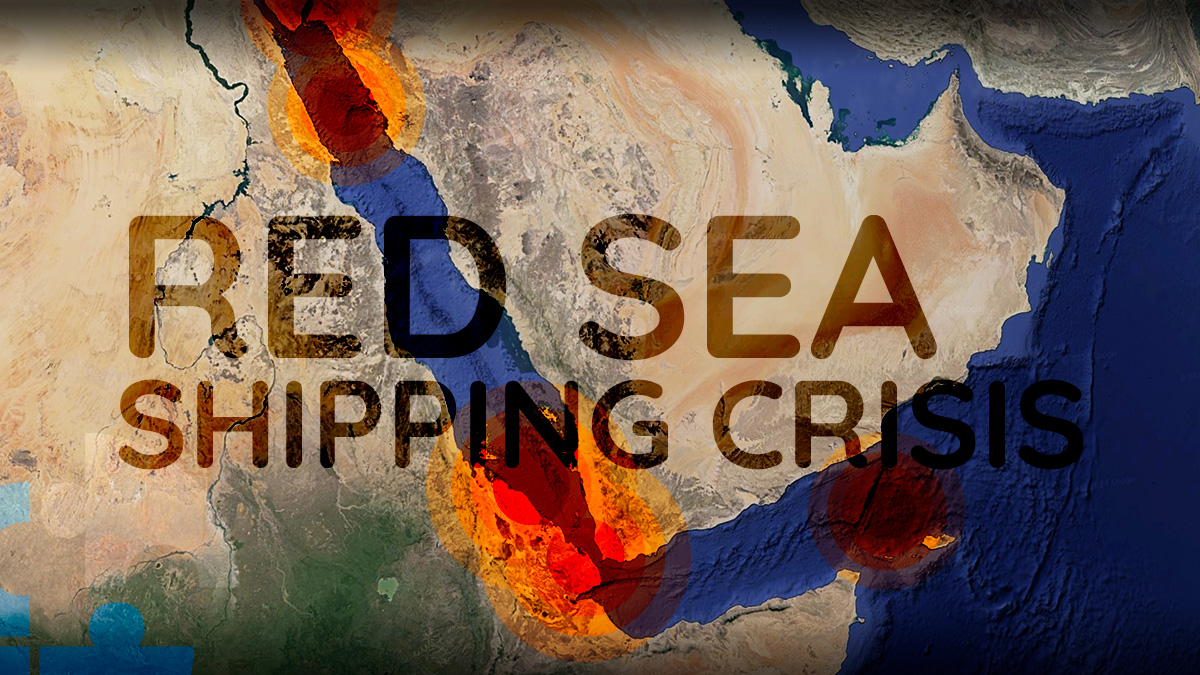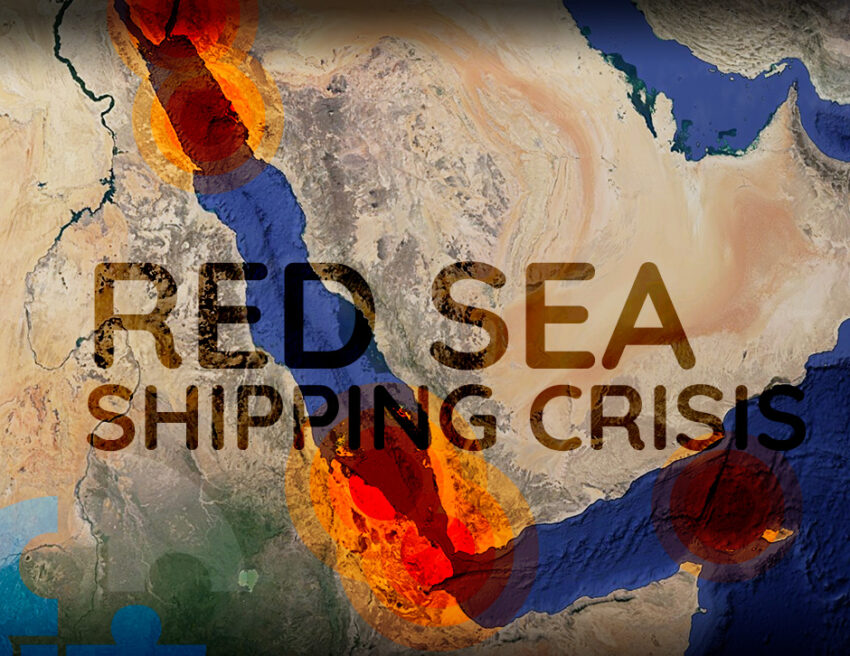Since November, Yemen’s Houthi rebel group has been targeting vessels passing through the Strait of Bab al-Mandab. This strait is a 20-mile (32km) wide channel that separates northeast Africa from Yemen on the Arabian Peninsula. The Strait of Bab al-Mandab is a critical maritime chokepoint, and any disruptions in this area can have significant implications for global shipping and trade and disrupt the operations of ocean freight forwarders.
The Red Sea crisis has had a substantial impact on shipping operations, with companies such as Maersk and others experiencing threats to their vessels. In response to these challenges, shipping companies have had to make rerouting decisions and implement operational pauses to ensure the safety of their assets and crew in the affected region. In today’s blog we are going to discuss the ongoing disruptions in the Red Sea and how it is influencing global shipping, routes and trade patterns and how to navigate the challenges posed by the crisis.
The importance of the Red Sea shipping route for ocean freight forwarders
The Red Sea plays a crucial role as a pivotal route for container shipping and international commerce, connecting the Indian Ocean with the Mediterranean Sea through the Suez Canal. This strategic waterway facilitates nearly 15% of global shipping traffic, establishing it as the fastest route between Europe and Asia.
In January 2023, Statista reports that 123.5 million metric tons of goods were transported through the Suez Canal in Egypt. Additionally, over 22,000 ships passed through the canal in 2022. Significantly, 12% of global trade by volume traverses this route, underscoring its immense significance in the world economy and the global logistics network. Any disruptions or crises in the Red Sea have widespread implications for international trade and maritime activities. These repercussions may include fluctuations in petrol prices, impacts on the availability of electronics, and disruptions to various other sectors dependent on the smooth flow of goods through this strategic waterway. The Red Sea’s importance to international trade underscores the global consequences of any challenges or crises in this region.

Implications of the Red Sea Crisis for the ocean freight industry
The challenges of the alternative route
Navigating through the threats in the Red Sea not only poses life risk for the sailors but also brings about higher insurance premiums, potential legal issues, and unpredictable delays. The cargo carried by these vessels can be of significant value, ranging from millions to hundreds of millions of dollars. Given these considerations, many shipping companies have opted to redirect their vessels elsewhere, avoiding the risks associated with the region.
However, choosing to steer clear of the Red Sea and take the longer route around the Cape of Good Hope comes with its own set of challenges. This detour adds approximately 3,500 nautical miles (4,000 miles/6,500 km) and extends the sailing time by 10-12 days for each trip. The repercussions include the need for extra fuel (with estimates suggesting an additional $1 million/£790,000 worth), potential adjustments to alternative ports of call, modifications to delivery timetables, and increased overall costs. Despite these challenges, many companies are making this choice as a safer alternative to the risks associated with potential missile attacks and hijackings in the Red Sea.
The decision to avoid the Red Sea has left container lines in a challenging situation, prompting them to urgently secure additional ship rentals for the extended journeys required to circumvent the region. Simply put, the shipping industry’s adaptations to avoid the Red Sea crisis may introduce complexities and disruptions throughout the global supply chain. It could influence trade patterns and contribute to fluctuations in product availability and pricing.
Increase in ocean freight rates
According to Juadah Levine, Freightos Head of Research, new rates and surcharges introduced by carriers may drive near-term prices for the Red Sea lane to exceed $6,000 per FEU (Forty-foot Equivalent Unit) as volumes are anticipated to shift to the West Coast. While season lulls following the Lunar New Year in late January could lead to lower rates later in February, it is expected that prices may remain higher than usual until Red Sea container traffic resumes normal levels. The adjustments in rates and surcharges reflect the ongoing challenges and disruptions in maritime routes, impacting shipping costs and trade patterns in the affected regions.
Unavailability of container
According to Sea-Intelligence and other maritime officials, approximately 10% of the world’s fleet is currently not in service. The deployment of these additional vessels could potentially address the imbalance in vessel availability and enhance predictability in vessel schedules. Moreover, to navigate around the Cape of Good Hope, ocean carriers would require one or two extra vessels to compensate for the delays caused by avoiding the Red Sea. As a solution, industry experts anticipate that ocean carriers will introduce additional vessels into their rotations following the Chinese New Year. The objective is to provide a viable alternative to the challenges posed by the Red Sea crisis, ultimately ensuring a more stable and efficient maritime transportation system.
The addition of vessels to the flow of trade could potentially alleviate concerns about a container crunch that has been worrying logistics managers. When vessels experience delays, the containers on those vessels will also be delayed in their processing and reuse for subsequent exports. This delay can impact exports from Europe to the United States, as well as from Asia to the United States and other parts of the world. Furthermore, the rerouting of vessels could lead to container shortages for several weeks, highlighting the broader implications of disruptions in maritime routes on the global supply chain and trade dynamics.
How ocean freight forwarders can deal with this situation
Ocean freight forwarders facing the challenges posed by the Red Sea crisis can adopt several proactive measures to protect their supply chains:
- Develop a Plan and Communicate: To begin with, shipping companies should create a comprehensive plan and engage in discussions with shipping lines. This will enhance their understanding of the situation and enable them to take necessary steps to safeguard their supply chains.
- Secure Capacity Early: Sea freight companies should book space on ships and planes at the earliest opportunity to ensure timely transportation of their goods.
- Ensure Equipment Availability: Logistics companies also need to confirm the availability of containers and space on board the ship for their goods. Coordination with the carriers is crucial to guarantee the presence of necessary equipment.
- Accelerate Movement of Goods: To prevent the accumulation of high floating inventories, shippers should expedite the movement of their goods. Swift transportation will help avoid additional costs associated with prolonged storage.
- Act Promptly, Especially Pre-Chinese Lunar New Year: Shippers should act promptly to secure capacity, considering the traditional capacity squeeze leading up to the Chinese Lunar New Year.
- Be Prepared for Higher Rates: Shippers should be ready to pay higher rates for ocean freight shipping, recognizing the need for reliability and stability amid the Red Sea crisis. This willingness to pay premium rates will assist in securing essential capacity and equipment, ensuring on-time transportation of goods.


